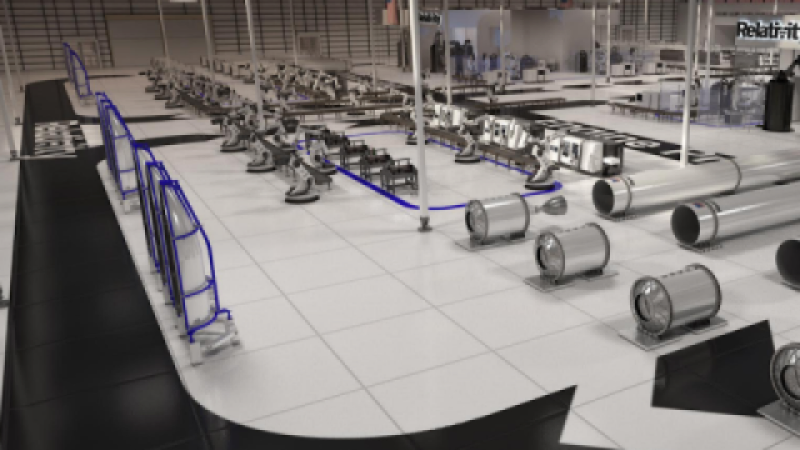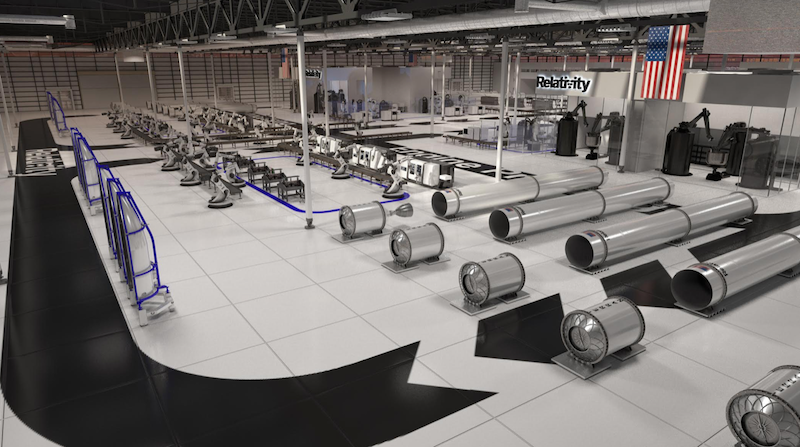NASA to Lease 3D Printing Rocket Factory
Article By : George Leopold

Rocket startup Relativity expands operations at NASA's Stennis Space Center
Entrepreneurs continue to integrate themselves into the U.S. space infrastructure as part of ongoing efforts to reduce launch costs while boosting access to low-earth orbit and beyond.
While SpaceX and Blue Origin rightly get most of the attention for their ability to launch, recover and reuse boosters, other startups are focusing on reducing the cost of manufacturing rockets and shrinking components counts to help unclog aerospace supply chains. Among the most innovative is Relativity, which bills itself as world’s first autonomous rocket factory. The Los Angeles-based startup has been ramping up its launch services as it acquires access for NASA manufacturing and launch facilities.
This week, Relativity announced it will lease manufacturing and test facilities at NASA’s Stennis Space Center in Mississippi. The deal calls for Relativity, a pioneer in additive manufacturing, to install a full-blown 3D printing rocket factory at Stennis where the company will produce its Terran 1 rocket.

The components of the mighty Saturn V rocket used to send humans to the moon during Project Apollo were test-fired and shipped from NASA’s Stennis Space Center in the 1960s.
Relativity said its Stennis facility will include a complete 3D printing and robotic production line for the Terran 1’s first stage along with engine integration and testing. The $59 million investment over five years is expected to create about 200 jobs.
In May, Relativity announced a launch services agreement to boost payloads into low-earth orbit using the entirely 3D-printed Terran 1 rocket. The first orbital flight remains scheduled for December 2020.
Relativity can build a rocket using additive manufacturing techniques in less than 60 days, initially lofting payloads as large as 1,250 kg (2,755 pounds).
The two-year-old startup founded by a pair of twenty-something veterans of Blue Origins and SpaceX built the world’s largest metal 3D printer called Stargate. The 15-foot-tall robot includes a company-designed printer head. The prototype 11-kilowatt laser melts aluminum which is shaped into various rocket components.
The nine-year Stennis lease initially includes 220,000 square feet of space, an 80-foot “high bay” and several bridge cranes. All will allow Relativity to scale its 3D manufacturing operations well beyond the confines of its current LA facility.
The rocket startup also has brought in Tesla veteran Tobias Duschl to oversee the expansion of its manufacturing and test operations, Stennis represents a “huge opportunity as an infrastructure resource,” said Duschl, adding that Relativity is now in the process of a phased move-in.
It expects to be up and running over the next three months as new equipment including upgraded 3D printers are installed. At full production, Duschl said the rocket factory will be able to produce up to 24 rockets a year.
Besides the novelty of manufacturing rockets using huge 3D printers, CEO Tim Ellis touts its autonomous manufacturing approach as a way of drastically reducing part counts by printing about 95 percent of rocket components. Moreover, the startup is able to iterate designs in about 60 days.
As for the move to Stennis, which was underwritten through capital investment incentives via Mississippi’s development authority, Ellis notes: “It’s a big advantage having a factory at an engine test site.” Added Ellis, “Infrastructure is normally a massive investment.”
Relativity, SpaceX, Blue Origin and others have leased or purchased idle NASA facilities at Stennis as well as Cape Canaveral. For example, SpaceX launches its Falcon 9 rockets from the same complex used during the Apollo lunar landing missions.
Asked what manufacturing lessons he learned during his stint at electric automaker Tesla, Duschl cited the need to maintain hardware simplicity while reducing part counts. “That’s where automation can really kick in,” he added in interview.
Relativity has been testing is 3D-print rocket engines at Stennis under a separate long-term lease. It has so far conducted 180 engine tests, including 136 test firings of its 3D-printed Aeon 1 engine that uses a combination of liquid methane and liquid oxygen. It’s also the first venture-backed rocket company to secure launching rights at Cape Canaveral.
Meanwhile, the startup is hiring, with job openings for automation, propulsion and avionics engineers as well managers of its additive manufacturing and production operations.